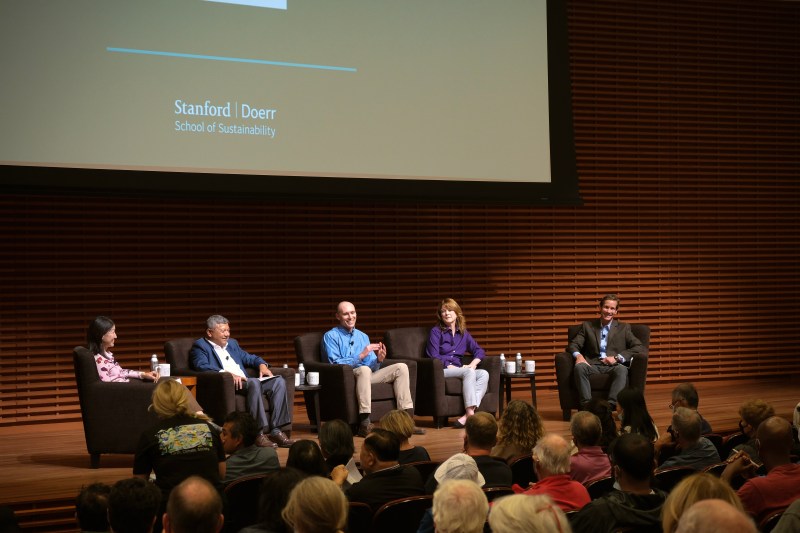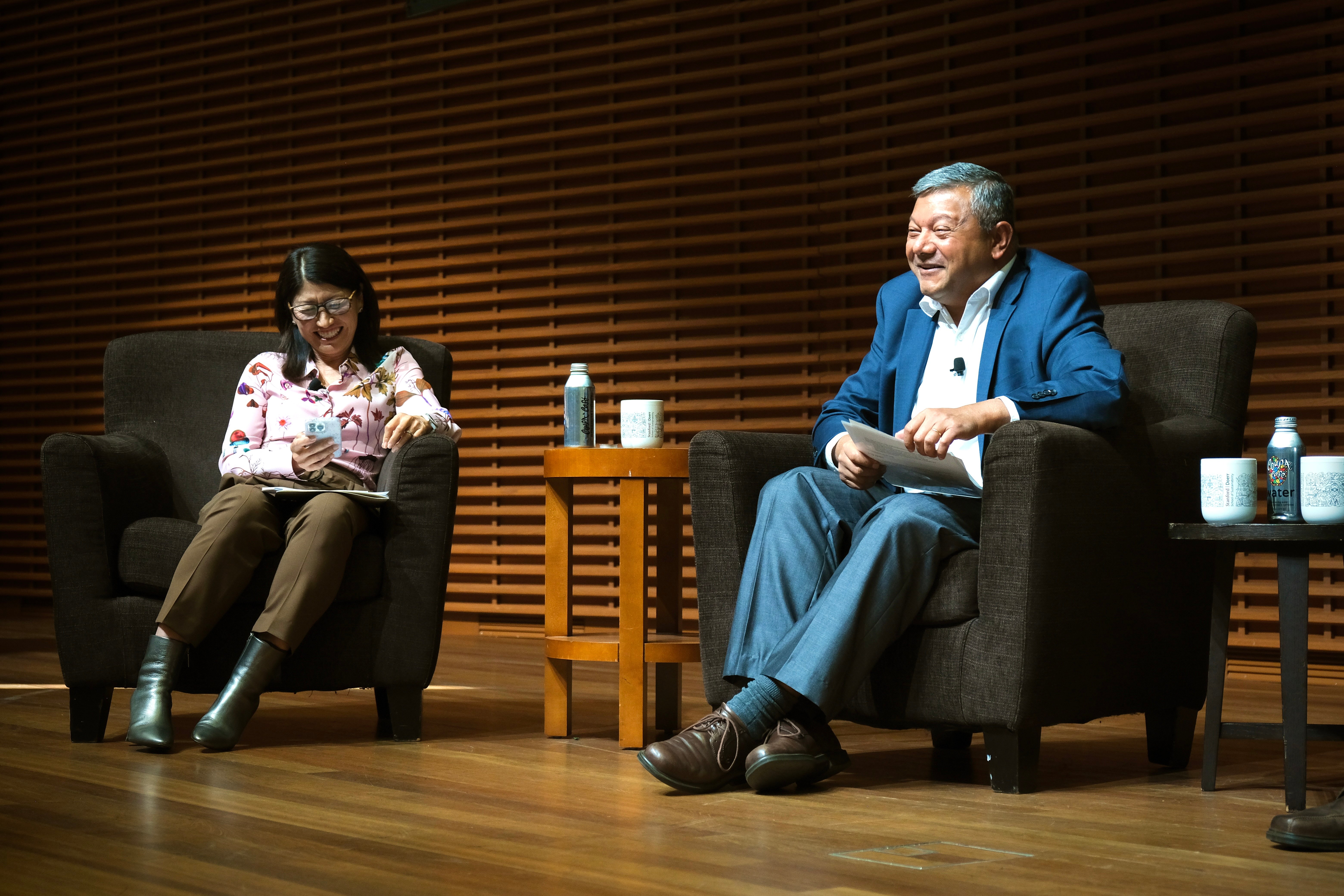The Doerr School of Sustainability leadership told alumni that the school is focusing on bringing diversity to Stanford faculty and expanding sustainability studies beyond STEM at a Friday fireside chat.
The chat brought together Dean Arun Majumdar, Senior Associate Dean Jonathan Payne, Senior Associate Dean Scott Fendorf and Associate Dean Jenna Davis at CEMEX Auditorium. John Doerr, investor and venture capitalist for whom the new school was named, was scheduled to attend but did not.
Before the event, students and alumni with Coalition for a True School of Sustainability, a group calling on Stanford to refuse funding from the fossil fuel industry, distributed flyers to attendees highlighting what the group alleged are inadequacies in the climate commitments of oil and gas companies funding Stanford research.
The flyers also called for a transparent process for industry-affiliated research and encouraged alumni to become involved. The activists also held signs reading “Shut the Doerr on Fossil Fuel” and “Freedom from Fossil Fuels” near the entrance of CEMEX.
The central question of the afternoon was “How can we reimagine academia to help solve some of the world’s greatest climate and sustainability challenges?” Vice President of Alumni Affairs Howard Wolf ’80 gave opening remarks, and the discussion was moderated by Akiko Yamazaki ’90.
Davis and Majumdar discussed the intellectual diversity of the Sustainability School and highlighted efforts to expand sustainability to the social sciences, including the Initiative for Sustainable Societies, a new initiative which will foster research in the economic and political aspects of sustainability. “This is really a microcosm of the campus that’s coming together,” Majumdar said.
The new school also brings demographic diversity in its faculty, according to Payne and Fendorf.
“The demographics of our faculty don’t always reflect very well the demographics of the students or the world that we’re working in,” Payne said. “Being able to hire a large number of faculty members over a short period of time on a university time scale gives us the opportunity to make our faculty composition closer in alignment to the world that we’re working in.”
“It’s really a focal point of the school. And I think that we are the first school that actually has an associate dean overseeing [diversity, equity and inclusion] efforts” Fendorf added.
Payne then discussed the location of the new school: “It’ll start over where Terman Fountain is, it’s what we’ll call the Sustainability Commons. That’ll have a walk that goes over to the Green Earth Sciences Building. And then two new buildings that are out towards the back side of Y2E2, which will become a front side of Y2E2.”
Payne also described how the Doerr School of Sustainability will change the educational experience at Stanford. By funding new classes and creating certificate programs for undergraduates, expanding graduate programs, including the social sciences, and opening internship opportunities through the Sustainability Accelerator, an incubator for Stanford researchers to turn their research to action, the school aims to make sustainability accessible to Stanford students of all backgrounds.
“Our goal is to reach as many Stanford undergraduates as possible with classes whether or not they are majoring in a major that’s housed within our school,” Payne said.
During the discussion, the speakers stressed the importance of working with international partners most directly impacted by climate change and the energy transition.
Majumdar emphasized the need to collaborate with international partners that are closest to the effects of climate change and “engaging them and listening to what the real issues are on the ground, not what we perceive in Silicon Valley.”

The speakers were optimistic about new relationships between Stanford and outside partners. “The world is knocking,” Davis said, “we are getting dozens of inquiries every week from institutions in the public, private and academic sectors that want to explore potential collaboration with the Doerr School.”
Davis did not specify which organizations inquired about partnerships, but they would join the ranks of public institutions such as the U.S. Department of Energy, fossil fuel companies such as Chevron and other for-profit companies such as Toyota.
Yamasaki asked Majumdar about fossil fuel funding for the new school. Majumdar said that it is an important issue but maintained that further deliberation was needed to make a final decision.
“It’s premature to take any steps before we’ve heard all of the voices, and that’s what’s going on,” he told Yamazaki. Majumdar is conducting a listening tour to gather perspectives from the Stanford community and intends to publish the results at the end of the fall quarter.
Combining pre-submitted questions from the audience, Yamazaki also asked Majumdar if the school would have a focus on a specific area of energy. Majumdar began by expressing his personal belief in nuclear energy as a key transition fuel for the energy transition. “We all want to be fossil free. The question is really: what is the pathway that keeps the energy system reliable?” Majumdar explained. “Nuclear, personally I feel, ought to be,” he added.
While it is a well-established source of energy that does not produce carbon dioxide, nuclear energy is somewhat controversial on Stanford campus. While some faculty champion it as a much-needed source of green energy, others advocate against nuclear power, due to the technology’s radioactive waste and high capital costs.
Majumdar did not elaborate on how the sustainability school will pursue nuclear energy, but instead went on to explain that we need to transform our electricity systems to accommodate the fluctuating renewable energy sources, through means such as energy efficiency.
